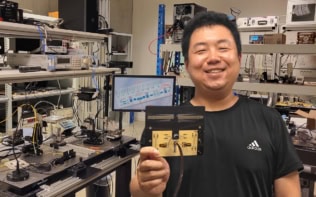The ability to stop light in its tracks by passing it through a cloud of ultracold atoms could lead to new techniques for optical storage
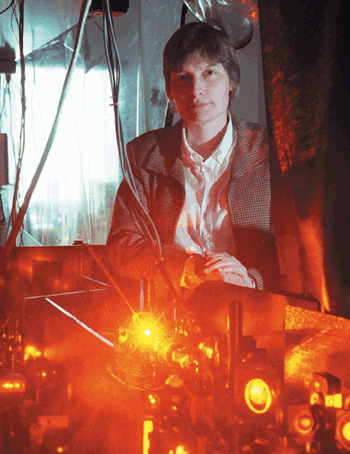
As anyone who uses the Internet will know, the last 10 years have seen some incredible developments in communication. We can now e-mail colleagues thousands of miles away and download research papers from distant servers in seconds. Much of this extraordinary progress has been due to improvements in optical communication. And, despite recent reports of a financial downturn in the optical-technology sector, we are now at a very exciting stage as far as the technology itself is concerned.
Nevertheless, the way we communicate optically is still rather old fashioned. We send optical pulses down a fibre and then, at every important intersection, convert the information into electronic signals. We then process the information electronically – before converting it back to optical signals and sending it on its way again, down another optical fibre.
If we are to keep improving the speed at which we communicate, we will have to find ways of avoiding these conversion steps so that we can process the information optically. One way of doing this is through nonlinear optics – in which one laser beam is used to change the optical properties of another. Although nonlinear optics has traditionally been viewed as an unwanted effect, causing pulses to spread and destroying information, that view is now changing. In the future, nonlinear optics could be used to make optical switches, delay lines, diodes and phase modulators – all of which would be required for purely optical processing.
To really push the boundaries in optical communication, however, we will have to follow completely new avenues of development that will be more than just perturbations of the progress we have seen so far. Non-classical, quantum-mechanical systems are likely to play an important role. They will offer completely new possibilities for optical media, and I predict that we shall see much progress at the interface between physics, applied physics and engineering.
A very exciting possibility for optical communication concerns the recent discovery that light can be slowed down by many orders of magnitude – and even be brought to a complete standstill – in a cloud of ultracold atoms. The ability to halt light in its tracks could lead to remarkable new ways of storing and manipulating optical signals and even to new techniques for quantum computers and communications.
Slowing light to a standstill
The story began three years ago in August 1998, when my research group at the Rowland Institute in Cambridge, Massachusetts, succeeded in reducing the speed of a pulse of light to just 38 miles per hour – about the speed of a Tour de France racing cyclist. What we did was to cool sodium atoms to just 50 billionths of a degree above absolute zero and then illuminate them with a carefully tuned laser beam. This “coupling laser” changed the optical properties of the atoms so dramatically that when a separate laser pulse was sent through the cloud of atoms, its speed was reduced by a factor of some 20 million. The size of the light pulse was also affected, shrinking from 1 km in free space to only 0.05 mm inside the medium. The pulse was then completely contained within the 0.1 mm long, cigar-shaped ultracold-atom cloud.
A very interesting application of ultra-slow light lies in the massive optical nonlinearities that are generated whenever light is slowed to such very slow speeds. Nonlinear optics – which can be used, for example, to increase the frequency of laser light – normally requires very powerful laser fields. However, we have demonstrated a “nonlinear refractive index” – a measure of how much a laser beam can change the optical properties of a medium as seen by another laser beam – that is 14 orders of magnitude larger than in an optical fibre. Indeed, it is the largest nonlinear refractive index ever measured by a factor of a million. Our work has opened up a new regime of nonlinear optics at extremely low light levels. In fact, nonlinear optics close to the single-photon level is even possible.
Recently we have gone a step further. Not content with just slowing light down, we have actually been able to stop, park and regenerate individual light pulses. In other words, we have found a way of storing and retrieving optical information – including phase information – using an atomic medium, with 100% efficiency in read/write operations. We obtain these low light speeds – and stopped light itself – in a new optical medium formed from an entangled system of ultracold atoms and a coupling laser. The optical properties of this coupled system can be changed by simply adjusting the intensity and frequency of the coupling laser. The characteristics of the system rely on fragile quantum-mechanical effects.
Slow light could be used, for example, to create very sensitive optical switches. By using a coupling laser to make a cloud of cold atoms initially transparent to pulses of light, a third laser beam could then be used to control whether or not the pulses pass through the cloud. Turning the third laser on would prevent the pulses from being transmitted; turning it off would transmit the pulses once again. The energy needed to flip the system between the two states could be as small as the energy of just two photons, while the speed of the switching operation could be controlled by adjusting the intensity of the coupling laser and/or the shape and density of the trapped, cold-atom cloud.
Another equally intriguing possibility is the creation of “optical delay lines” – devices that can delay optical information if too much of it arrives at the same time. (They could force the light pulses into a “holding pattern”, just as aeroplanes are held in formation in the sky until a runway at a congested airport becomes available.) With ultracold atoms and ultra-slow light, we can obtain delays of between micro- and milliseconds in a medium that is just 0.1 mm long. Although we could obtain similarly large delays by sending light down an optical fibre, the fibre would have to be up to several hundreds of kilometres long! Another very important aspect of our proposed delay lines is that the delays could be continually adjusted to meet one’s needs by simply changing the intensity of the coupling laser.
Creating ultracold clouds of atoms
So how do we create this rather unusual medium that can slow down and even stop light? What we do is cool atoms trapped in an electromagnet to very low temperatures – an “atom refrigerator”, if you like (figure 1a). The atoms originate from a specially designed “candlestick” atomic-beam source, so named because it works just like a candle. Atoms are drawn by capillary action from a pool of hot liquid sodium up a fine gold-plated steel mesh (the wick) to a heater that vaporizes them (figure 1b). An intense jet of hot sodium atoms then shoots out of a pinhole with an average velocity of 700 m s-1. These atoms are much too fast to be used directly so we immediately hit them head-on with a laser beam, using radiation pressure to slow the atoms down in a 1 m long magnetic device known as a “Zeeman slower”. The device is so effective that one millisecond later the atoms have slowed to just 50 m s-1.
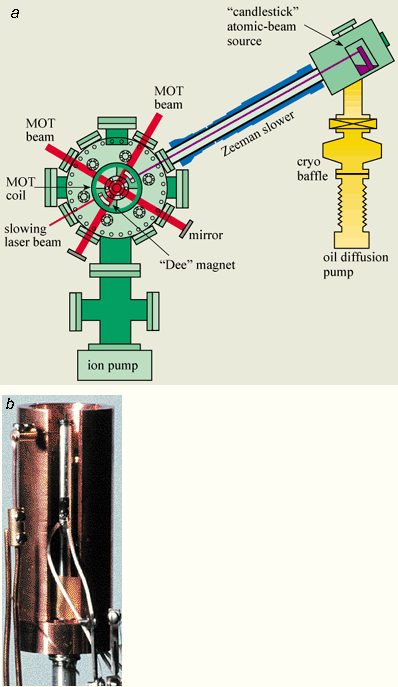
At this point we load the atoms into an “optical molasses” – the region in the middle of our main ultrahigh-vacuum chamber where three pairs of counter-propagating yellow laser beams, tuned to just below an atomic resonance, converge. Those atoms that see the light Doppler-shifted to a frequency that they can absorb, recoil from the small momentum kicks of the absorbed photons, slowing down and cooling in the process. Within a few seconds, the optical molasses holds about 10 billion atoms cooled to 50 millionths of a degree above absolute zero. This is extremely cold. But we want our sample colder still!
For the next cooling step, we turn off all the laser beams so there is complete darkness in the lab. At the same time, we turn on 1000 A of current in the “4 Dee” electromagnet, which is in the shape of four letter Ds. Since sodium atoms have a magnetic dipole moment, we can trap them in the magnetic-field minimum that lies at the centre of the electromagnet.
We then start the process of “evaporative cooling”, which works in rather the same way that a cup of coffee cools. The hottest atoms escape, leaving the left-over atoms to collide and re-equilibrate at a lower temperature before the next set of hot atoms depart and the remainder cool further still. We do not, however, actually wait for the hottest atoms to leave: we help them on their way using “magnetic resonance spectroscopy”. By applying a radio-frequency field and sweeping through the frequencies in a carefully orchestrated way, we keep kicking out the hottest atoms until we are left with a sample of magnetically trapped atoms that are so cold that their “de Broglie” wavelengths are comparable to the distance between the atoms.
At this point, when the atom cloud has been cooled to a temperature of about 500 billionths of a degree above absolute zero (500 nK), we can start to form a “Bose–Einstein condensate”. This is a very odd state of matter in which several million atoms behave in a completely correlated fashion – like a superatom (see Bose condensates make quantum leaps and bounds Physics World August 1999 pp37–42). It is a state of matter that has properties similar to superconductors and superfluids. First predicted in the 1920s, Bose–Einstein condensates were finally observed in 1995 by Eric Cornell, Carl Wieman and co-workers at the JILA lab in Boulder, Colorado.
The cold-atom clouds contain neutral atoms, which – unlike ions – interact only very weakly with their surroundings. So even when an atom cloud has been cooled to 500 nK, the rest of the system – including the vacuum chamber that is in close proximity to the cold atoms – can be kept at room temperature. This is important for potential practical applications of our new optical medium.
Slowing down light – the secret
We now have ultracold atoms: so how do we use them to slow light down? Traditional materials, such as a block of glass, can slow light by 30% or 40% compared with its speed in a vacuum. However, to slow down light by six or seven orders of magnitude, we cannot rely entirely on classical mechanics and have to turn instead to quantum mechanics for help.
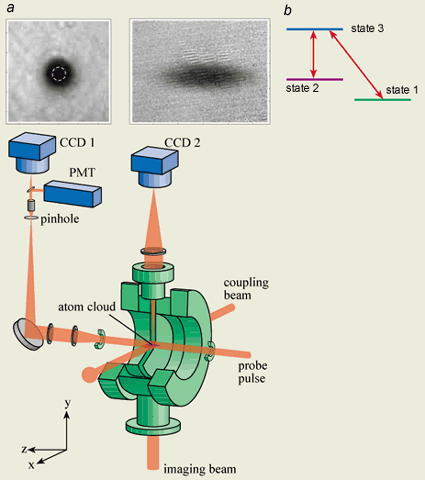
After we have evaporatively cooled the sodium atoms, they are all in one particular internal quantum state, 1 (figure 2b). This is an important point: the magnetic field that traps the atoms while evaporative cooling takes place acts as a filter – only those atoms in this state are trapped in the magnet. So having produced a cold-atom cloud trapped between the poles of an electromagnet – the cigar-shaped cloud is typically 0.1–0.2 mm long and 0.05 mm in diameter – we illuminate it from the side with a coupling laser beam. (The cloud does not have to be a Bose-Einstein condensate, but the most dramatic effects are obtained if it is in this special state.) The frequency of the coupling laser is chosen to match the energy gap between the two higher-energy states of the atoms, labelled 2 and 3 (figure 2). This means that the three states, 1, 2 and 3, form an almost closed system that has the special feature of having no (or very few) decays to other levels when the coupling and probe lasers are present. This requires the propagation direction, polarization and frequency of the laser beams to be very carefully controlled.
As its name implies, the coupling laser links or “couples” states 2 and 3 together, which means that we have to consider the mixture of the atoms and the coupling laser light as one complete system. The coupling laser splits the single energy level, corresponding to the energy of state 3, into two nearby levels. The splitting is proportional to the square root of the intensity of the coupling laser, which means that we have a way of controlling the energy levels of the coupled laser-atom system – and hence its optical properties.
We now fire a probe laser pulse, which we wish to slow, into the atom cloud. The frequency of the probe laser is adjusted until it is resonant, or almost resonant, with the 1 to 3 transition. The refractive index of the atom cloud, as seen by the probe laser beam, then varies in a very odd way with probe frequency: it has two “wiggles” centred on the two frequencies that correspond to the energy differences between 1 and the two new, split energy levels (figure 3). Furthermore, right on 1 to 3 resonance – when the probe laser is tuned precisely midway between the two split energy levels – the refractive index is exactly 1, just as it is in free space. The key point is that the refractive-index profile has a very steep slope around resonance. In other words, we do not slow light by creating a medium with an absolutely enormous refractive index! The “secret” is, rather, to create a very steep slope in the refractive-index profile around resonance. The speed at which a pulse propagates – the so-called group velocity – is inversely proportional to the slope. We get the steepest slope – and hence the slowest light – by minimizing the distance between the split energy levels of the mixed atom-light system, i.e. by applying a very weak coupling laser.
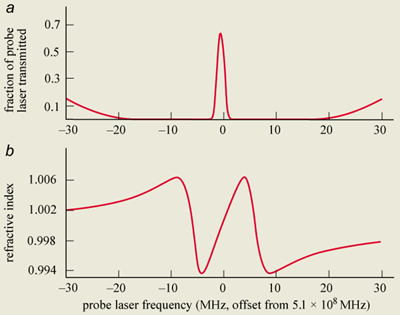
It is important to note that our probe light pulse does not have one well defined frequency. It is actually a superposition of travelling plane waves that have a distribution of frequencies. The speed of each plane wave – the so-called phase velocity – is determined by the refractive index at that frequency. In our system, where the index is about 1, the phase velocity is very close to the velocity in free space, i.e. 300,000 km s-1. Around resonance, where the refractive index varies so steeply, the different planes waves all have slightly different phase velocities. These plane waves add up to form the light pulse, and the point of maximum constructive interference between the different components determines the peak of the pulse. It is the group velocity – the speed of this pulse peak – that is slowed to almost a halt.
When we use really cold samples, the atoms hardly move at all, and their energy levels do not smear out due to Doppler effects. This means that the energy levels of the coupled atom-laser system can indeed be brought very close together without overlapping. It is also important to realize that the refractive index stays very close to 1 for all the frequency components in the pulse. If we tried to slow light by creating a material with a huge refractive index – say, larger by a factor of several tens of millions than in free space – our probe laser pulse would reflect off the material. It would simply not be able to enter the material in the first place. The fact that the refractive index stays close to 1 also means that the wavelength of the light pulse and its peak electric-field strength are the same inside as they are outside the medium.
Coupling effects
Another important point of these experiments is that if we did not have a coupling laser, our dense, cold-atom cloud would be completely opaque to the resonant probe laser pulses. It is only in the presence of the coupling laser that the medium becomes transparent. This effect, known as “electromagnetically induced transparency”, was first observed by Steve Harris and co-workers at Stanford University in California in the early 1990s.
So how does the coupling laser pull off this trick? The answer is that the coupling and probe lasers create a “quantum-mechanical interference” in the system. The atoms, which are initially all in state 1, cannot absorb the coupling beam because it is tuned to the energy difference between states 2 and 3. However, when the probe pulse arrives, the two beams shift the atoms to a quantum superposition of states 1 and 2. If the atoms had stayed in state 1, they would have absorbed the probe light, which is tuned to the energy difference between states 1 and 3. And if the atoms were all in state 2, they would have absorbed the coupling laser beam. (In both cases, the atoms would have jumped to state 3 and then spontaneously re-emitted photons in a random direction and the cloud would have glowed yellow.)
But because the system is in a quantum superposition state, the two absorption processes cancel each other out. The superposition state is called a “dark state”. Neither the probe pulse nor the coupling-laser field is absorbed: the system is transparent. This quantum interference is also responsible for the fact that we can keep the steep refractive-index profiles in the presence of spontaneous radiation damping from state 3.
The relative proportions of states 1 and 2 needed to make the system dark varies according to the relative electric-field strengths of the probe and the coupling lasers. In fact, the system is already dark even before we turn the probe laser on because all the atoms start out in state 1, which cannot absorb the coupling laser. We then keep the atoms “dark” by turning on the probe pulse slowly enough to allow the superposition state to continually adjust: the more probe intensity we have, the more atoms will be in state 2.
Impressions of compressions
The tremendous deceleration of light pulses is not the only impressive feature of these experiments. The fact that the pulses are compressed so much in size is equally remarkable. What happens as a pulse enters an atom cloud, lit by the coupling laser, is that the front edge of the pulse slows down, while the back edge – still in free space and travelling at 300,000 km s-1 – catches up. The pulse starts to compress, like a concertina. At the centre of the cloud, where the atomic density is the greatest, the speed and spatial extent of the light pulse are minimized. The pulse is spatially compressed by the same factor as it is slowed down.
Since the maximum amplitude of the pulse’s electric field stays the same as it passes through the atomic cloud, energy is clearly missing from the pulse. Part of that “missing energy” is temporarily stored in the atoms, but most is transferred to the coupling-laser field through stimulated emission. When the pulse leaves the medium, however, the energy is transferred back to the light pulse. The pulse regains the shape it had before it entered the medium, although it is greatly delayed.
We have directly measured this energy transfer by monitoring the coupling laser field with a light detector. As the probe laser pulse propagates slowly through the medium, the atoms within the compressed, localized light-pulse region will, at any given time, be in a dark superposition state. The spatial distribution of the dark states mimics the spatial distribution of the probe pulse.
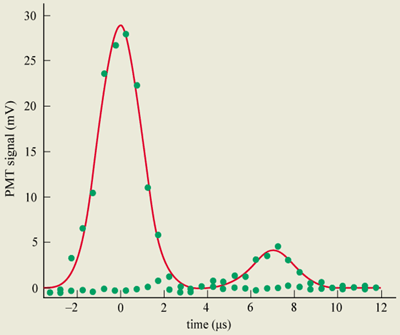
Measuring the speed of our ultra-slow light is relatively easy. Having illuminated the cloud from the side with the coupling laser and fired the probe laser pulse into the atom cloud along its long axis, we simply sit behind the cloud and wait for the light pulse to emerge. We use a photomultiplier tube to measure the arrival time (figure 4). All we then need to do to find the speed of the light pulse is to measure the length of the atom cloud, which we do with a third laser beam, the “imaging” beam (figure 2a). This laser propagates at right angles to the coupling and probe laser beams, passing vertically through the cloud. The atoms create an “absorption shadow” in the imaging beam, which is recorded with a camera that takes a snapshot of the cloud.
Stopping the light pulse
Having learned how to slow light pulses to crawling pace – and compress them so that they are completely contained within our ultracold-atom clouds – we then decided to try a different experiment. When the slow-light pulse had reached the centre of the cloud, we turned off the coupling laser abruptly. The result: no pulse came out. When we later turned the coupling laser back on, the light pulse was regenerated and emerged from the cloud.
What happens when the light pulse slows down is that it is compressed by a factor of some ten million, leaving an almost negligible amount of energy in the pulse. (In free space the pulse contains 25,000 photons and, once compressed, it contains only 1/400 of a free-space photon.) When we turn the coupling laser off abruptly, the light pulse comes to a grinding halt, and the atoms within the localized pulse region are left in their superposition “dark states”. In these states, the relative proportions of states 1 and 2 is a measure of the electric-field ratio between the light pulse and the coupling laser before turn off. In effect, we imprint a phase grating in the atom cloud as if we were recording a hologram.
When we later switch the coupling laser back on, the information left in the atoms – the “grating” – dictates how the light pulse should be regenerated. If we turn the coupling laser back on at the same intensity it had before it was switched off, we generate an exact copy of the light pulse we stored in the cloud. It has the very same shape and wavelength. However, by turning the coupling laser on at a higher intensity, we can generate a revived light pulse that is more intense than the one we sent in and, furthermore, is temporally compressed (i.e. shorter). By turning the coupling laser on and off rapidly a couple of times, we have also been able to regenerate two and even three small light pulses from just one pulse sent into the medium. We have succeeded in storing the pulse in the medium for very long periods of time: several milliseconds in fact. During that time, a light pulse travelling at normal speed would have shot hundreds of miles into the distance. The process of stopping, storing and reviving light is extremely robust. We can slam the coupling laser on and off, and the system – almost magically – self-adjusts to avoid absorption and loss of information.
We are excited that our slow-light experiments have triggered so much new physics both on the theoretical and experimental fronts. Slow light has since been obtained in gases at room temperature by Marlan Scully and his group at Texas A&M University and by Dimitry Budker and co-workers at the University of California at Berkeley. Meanwhile, Ron Walsworth and Mikhail Lukin at the Harvard-Smithsonian Center for Astrophysics in the US have obtained stopped light using a similar process to ours, but with co-propagating probe and coupling laser beams in a hot gas. Other researchers have even managed to create light that travels faster than its speed in a vacuum (see box below).
The cold-atom system allows for the steepest possible refractive-index profiles – and therefore for the most dramatic effects – as Doppler effects are eliminated. Furthermore, cold atoms provide maximum flexibility in the choice of beam geometry. This is important, for example, for the storage and retrieval of multiple pulses of optical information in an atomic medium, as it would allow individual pulses to be selectively addressed.
Superluminal light
Bringing light to a standstill is not the only effect that a laser-manipulated atomic gas can have on a light pulse. Last year Lijun Wang and co-workers at the NEC Research Institute in Princeton, New Jersey, pushed the speed of an electromagnetic pulse to greater than the speed of light in vacuum by passing the pulse through a chamber filled with caesium gas (L J Wang, A Kuzmich and A Dogoriu 2000 Nature 406 277). Superluminal propagation was previously observed in independent experiments by Steven Chu at Stanford University in the US, Vladilen Letokhov of the Russian Academy of Sciences in Troitsk and Ray Chiao of the University of California at Berkeley.
In the Princeton work, the researchers illuminated a 6 cm long cell of caesium atoms with two pump lasers that were at slightly different frequencies and both tuned somewhat away from an atomic resonance (see No thing goes faster than light by Aephraim M Steinberg Physics World September 2000 pp21–22). A refractive-index profile with a slope opposite to that in figure 3 was obtained. When a carefully tuned probe pulse was then fired into the medium, its speed became greater than the vacuum light speed. In fact, the pulse appeared to come out of the medium 60 ns before it entered!
However, Einstein’s general theory of relativity was not violated because information – due to quantum-mechanical fluctuations – cannot be carried faster than the vacuum light speed, even by the superluminal light pulses.
Future applications
Slow and stopped light have many potential applications in optical communication and processing, including optical information storage, ultra-sensitive optical switches, and optical delay lines. It could also be used in quantum-information processing, in which quantum-mechanical information is used for computing and communication purposes. Quantum computers could solve problems – in cryptography, for example – that cannot be solved on realistic timescales with a classical computer alone.
One of the big problems for quantum-information processing, however, has been the fact that we are unable to transfer quantum information back and forth with high efficiency between an optical field and an atomic system. But with our ability to stop, park and revive light, we could use stopped-light pulses to imprint quantum information on an atomic cloud. The information could be processed in the cloud through controlled atomic interactions, and we could then revive the light pulses and read the processed quantum information back into the light field where it could be sent further down an optical fibre.
On a very different front, slow light provides us with a totally new way of probing the unusual properties of Bose–Einstein condensates. Very recently, we have developed a light “roadblock” and used it to create ultra-compressed, ultra-slow light pulses that subsequently led to formation of “quantum shock waves” in a Bose–Einstein condensate. It might even be possible to use slow light to study cosmology in laboratories right here on Earth. Ulf Leonhardt from the University of St Andrews in the UK, for example, has predicted that the analogue of black holes could exist in such as system.
Ultra-slow light has opened up a whole new realm of applications and new paths for fundamental research. I believe we have only seen the tip of the iceberg.



